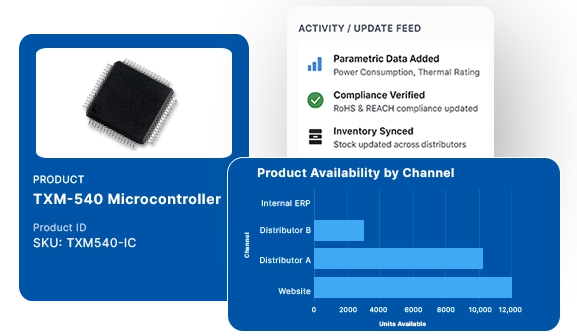Product information management system
Centralize, enrich and distribute your product data across channels. A PIM system built for enterprise-wide adoption and global growth.
Book a demoOur Clients

Product information that stays clear, consistent, and always available across channels helps your teams work faster and builds customers’ trust. Accurate data records, structured catalogs, and consistent digital touchpoints make this possible.
At Softweb Solutions, our team of 20+ PIM implementation experts helps companies with extensive product catalogs, multi-channel selling, and regional content needs. We do this through proven frameworks and tailored strategies. Your business may handle thousands of SKUs, complex supplier relationships, or product data tailored for different regional markets. We design, implement, and support product information management (PIM) solutions that simplify your eCommerce operations and elevate customer experiences.
Our product information management specialists help you move forward with steps like:
Organizes product catalogs for consistency and accuracy across systems. The PIM system applies predefined schemas, taxonomies, and hierarchies to keep records standardized and scalable.
Adds detailed attributes, high-quality media, and SEO elements to product records. Metadata, tagging, content templates, and category rules enable data enrichment across categories and channels.
Ensures reliability and completeness of product information through validation rules and data profiling. Automated checks, correction workflows, and audit trails maintain data integrity across the catalog.
Imports product data from ERPs, APIs, or spreadsheets with automated checks. Connectors, parsers, and transformation rules ensure smooth intake of product data from multiple sources.
Delivers unified product data across eCommerce sites, mobile apps, and marketplaces. Custom pipelines, APIs, and export templates keep product data aligned across different channels.
Adapts product data to regional languages, currencies, and formats. Built-in translation tools, localization workflows, and compliance checks ensure consistent content delivery worldwide.
Automates product content lifecycle from creation to approval using role-based controls. Configurable workflows, notifications, and escalation rules help teams coordinate tasks more effectively.
Links images, videos, and media files directly to products in a structured repository. Asset versioning, tags, rights control, and search tools make digital assets easy to manage, reuse and publish.
Provides dashboards that monitor completeness, channel metrics, and digital shelf analytics. Detailed views, filters, and reports help evaluate catalog performance.
Let’s discuss how you can simplify product data and drive growth with our Product Information Management (PIM) system.
Schedule a callFrom manufacturers managing detailed specifications to healthcare firms meeting compliance, product information needs vary. A PIM software adapts to these demands and delivers customized solutions for every industry.
Gathers scattered product details into one PIM system to create a unified source of truth
Enriches records with taxonomy, attributes, and digital assets for consistent outputs
Oversees workflows, access rights, and governance rules through flexible controls
Shares product data across eCommerce, marketplaces, and customer channels
Accelerated launches
Reduce catalog setup time and drive faster product rollouts
Precise records
Improve consistency and minimize costly catalog discrepancies
Collaborative workflows
Enable efficient alignment of marketing, sales, and operations
Customer engagement
Deliver clear, enriched information that drive better journeys
Scalable catalogs
Expand to thousands of SKUs without system slowdowns
Return reduction
Limit customer complaints by ensuring data accuracy across listings
Conversion growth
Provide trusted product details that improve purchase confidence
Regulatory compliance
Maintain product data standards across industries and regions
Identify catalog priorities and outline goals for a PIM implementation
Choose the most suitable PIM software for integration and workflows
Customize taxonomy, governance, and enrichment processes for smooth adoption
Launch in phases, gather feedback, refine, and scale as you grow
Enterprises trust PIM to unify product data, ensure accuracy, scale globally, and build customer trust.
Get in touchExpertise in handling catalogs with 200K+ SKUs across diverse product categories
Seamless integration of PIM with ERP, CRM, and eCommerce platforms for unified operations
Proven success in managing multi-language and multi-region catalogs for global enterprises
Accurate product data that reduces returns and improves consistency across all channels
Scalable PIM implementations designed to support complex enterprise ecosystems and future growth
Product information management organizes, consolidates, and maintains product data in a single repository. It ensures accuracy, consistency, and control across multiple platforms, channels, and business systems. A well-implemented PIM becomes the foundation for delivering reliable, channel-ready product information at scale.
Companies with large catalogs, multi-channel sales, or global operations require PIM for efficiency. The system helps manage complexity, maintain consistency, and improve time-to-market across regions. Enterprises also gain agility to adapt faster to new markets, channels, and customer demands.
Modern PIM software supports translations, localized content, and region-specific compliance. Businesses can deliver accurate product information tailored for diverse languages, currencies, and markets worldwide. Global enterprises rely on PIM to ensure every customer sees relevant, compliant, and market-ready product data.
A PIM platform ensures product data stays consistent across eCommerce, marketplaces, and retail. It unifies information, reduces errors, and enables seamless customer experiences across digital channels. Such consistency strengthens brand presence while helping businesses expand confidently across multiple digital marketplaces.
Enterprise-grade PIM systems include encryption, access controls, and compliance measures. Businesses safeguard sensitive product data while maintaining security across global platforms and distributed teams. Security-first design ensures compliance with evolving regulations while protecting customer and partner trust.
PIM implementation accelerates product launches, reduces catalog errors, and improves conversions. Companies gain efficiency, reduce returns, and achieve stronger outcomes across digital selling environments. Long-term benefits also include reduced operational costs and improved collaboration between teams and partners.
Yes, PIM integrates smoothly with ERP, CRM, and eCommerce systems. Integration happens through APIs, middleware, and prebuilt connectors, ensuring secure, real-time synchronization. Custom mapping and validation rules align product data seamlessly across platforms.
AI-driven PIM systems enrich data, automate updates, and predict catalog changes. Organizations gain speed, accuracy, and smarter decision-making for managing complex product ecosystems. AI adoption also prepares businesses for future-ready operations where product data management adapts dynamically to changing needs.
Make product information work smarter for you
We help businesses centralize, enrich, and distribute product data for stronger outcomes.


